
Interior Alaska is the central region of Alaska's territory, roughly bounded by the Alaska Range to the south and the Brooks Range to the north. It is largely wilderness. Mountains include Denali in the Alaska Range, the Wrangell Mountains, and the Ray Mountains. The native people of the interior are Alaskan Athabaskans. The largest city in the interior is Fairbanks, Alaska's second-largest city, in the Tanana Valley. Other towns include North Pole, just southeast of Fairbanks, Eagle, Tok, Glennallen, Delta Junction, Nenana, Anderson, Healy and Cantwell. The interior region has an estimated population of 113,154.

The Yukon River is a major watercourse of northwestern North America. From its source in British Columbia, Canada, it flows through Canada's territory of Yukon. The lower half of the river continues westward through the U.S. state of Alaska. The river is 3,190 kilometres (1,980 mi) long and empties into the Bering Sea at the Yukon–Kuskokwim Delta. The average flow is 6,400–7,000 m3/s (230,000–250,000 cu ft/s). The total drainage area is 833,000 km2 (321,500 sq mi), of which 323,800 km2 (125,000 sq mi) lies in Canada. The total area is more than 25% larger than Texas or Alberta.
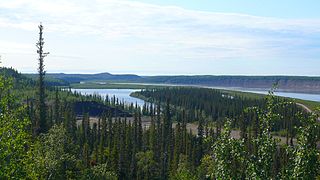
The Mackenzie River is a river in the Canadian boreal forest. It forms, along with the Slave, Peace, and Finlay, the longest river system in Canada, and includes the second largest drainage basin of any North American river after the Mississippi.
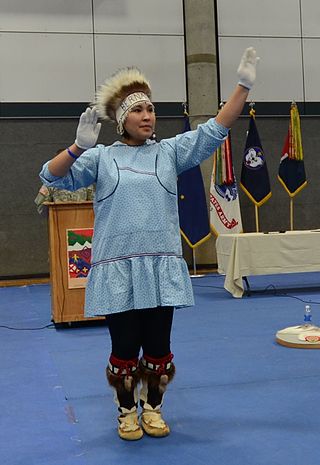
Alaska Natives are the indigenous peoples of Alaska and include Iñupiat, Yupik, Aleut, Eyak, Tlingit, Haida, Tsimshian, and a number of Northern Athabaskan cultures. They are often defined by their language groups. Many Alaska Natives are enrolled in federally recognized Alaska Native tribal entities, who in turn belong to 13 Alaska Native Regional Corporations, who administer land and financial claims.
The Green Belt Movement (GBM) is an indigenous grassroots organization in Kenya that empowers women through the planting of trees. It is one of the most effective and well-known grassroots organisations addressing the problem of global deforestation. Professor Wangari Maathai established the organization in 1977 under the auspices of the National Council of Women of Kenya (NCWK). GBM's successes in forest conservation, education, and women's economic empowerment have gained the organisation worldwide acclaim. It is also noted for its advocacy of human rights, democratisation of access to public lands, and environmental justice issues such as the role of women's traditional ecological knowledge in addressing environmental degradation and desertification.
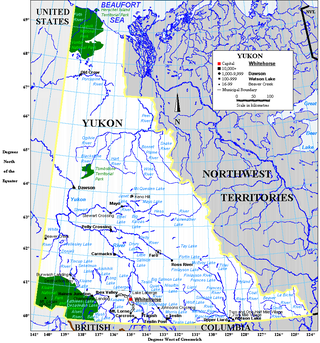
Yukon is in the northwestern corner of Canada and is bordered by Alaska and the Northwest Territories. The sparsely populated territory abounds with natural scenic beauty, with snowmelt lakes and perennial white-capped mountains, including many of Canada's highest mountains. The territory's climate is Arctic in territory north of Old Crow, subarctic in the region, between Whitehorse and Old Crow, and humid continental climate south of Whitehorse and in areas close to the British Columbia border. Most of the territory is boreal forest with tundra being the main vegetation zone only in the extreme north and at high elevations.

The Porcupine caribou(Rangifer tarandus groenlandicus) is a herd or ecotype of barren-ground caribou, the subspecies of the reindeer or caribou found in Alaska, United States, and Yukon and the Northwest Territories, Canada. A recent revision changes the Latin name; see Taxonomy.
Chattahoochee Riverkeeper (CRK) -- formerly known as Upper Chattahoochee Riverkeeper (UCR) -- is an environmental advocacy organization with 10,000 members dedicated solely to protecting and restoring the Chattahoochee River Basin. CRK was modeled after New York’s Hudson Riverkeeper and was the 11th licensed program in the international Waterkeeper Alliance. In 2012, the organization officially changed its name to simply Chattahoochee Riverkeeper (CRK), dropping the "Upper" to better reflect its stewardship over the entire river basin.

A fish wheel, also known as a salmon wheel, is a device situated in rivers to catch fish which looks and operates like a watermill. However, in addition to paddles, a fish wheel is outfitted with wire baskets designed to catch and carry fish from the water and into a nearby holding tank. The current of the river presses against the submerged paddles and rotates the wheel, passing the baskets through the water where they intercept fish that are swimming or drifting. Naturally a strong current is most effective in spinning the wheel, so fish wheels are typically situated in shallow rivers with brisk currents, close to rapids, or waterfalls. The baskets are built at an outward-facing slant with an open end so the fish slide out of the opening and into the holding tank where they await collection. Yield is increased if fish swimming upstream are channeled toward the wheel by weirs.

Arctic ecology is the scientific study of the relationships between biotic and abiotic factors in the arctic, the region north of the Arctic Circle. This region is characterized by stressful conditions as a result of extreme cold, low precipitation, a limited growing season and virtually no sunlight throughout the winter. The Arctic consists of taiga and tundra biomes, which also dominate very high elevations, even in the tropics. Sensitive ecosystems exist throughout the Arctic region, which are being impacted dramatically by global warming.
The Harvard Project on American Indian Economic Development, also known as the Harvard Project, was founded in 1987 at Harvard Kennedy School at Harvard University. It administers tribal awards programs as well as provides support for students and conducting research. The Harvard Project aims to understand and foster the conditions under which sustained, self-determined social and economic development is achieved among American Indian nations through applied research and service.
Traditional ecological knowledge (TEK) describes indigenous and other traditional knowledge of local resources. As a field of study in Northern American anthropology, TEK refers to "a cumulative body of knowledge, belief, and practice, evolving by accumulation of TEK and handed down through generations through traditional songs, stories and beliefs. It is concerned with the relationship of living beings with their traditional groups and with their environment." Indigenous knowledge is not a universal concept among various societies, but is referred to a system of knowledge traditions or practices that are heavily dependent on "place". Such knowledge is used in natural resource management as a substitute for baseline environmental data in cases where there is little recorded scientific data, or may complement Western scientific methods of ecological management.
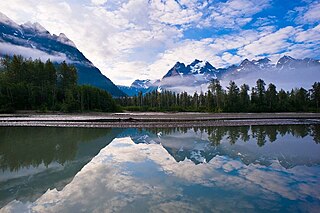
Rivers Without Borders is a nonprofit organization fiscally sponsored by the Tides Center in the United States. Rivers Without Borders works as a project of Tides Canada Initiatives in Canada. Tides Canada's mission is to provide uncommon solutions for the common good by leading and supporting actions that foster a healthy environment and just Canadian society.

The Arctic policy of the United States is the foreign policy of the United States in regard to the Arctic region. In addition, the United States' domestic policy toward Alaska is part of its Arctic policy.

The Pacific Salmon Commission is a regulatory body run jointly by the Canadian and United States governments. Its mandate is to protect stocks of the five species of Pacific salmon. Its precursor was the International Pacific Salmon Fisheries Commission, which operated from 1937 to 1985. The PSC enforces the Pacific Salmon Treaty, ratified by Canada and the U.S. in 1985.

Clarence Lee Alexander is a former Grand Chief of the Gwich'in of Alaska. He was 1st Chief of Fort Yukon from 1980 to 1994. He was raised at "Shoo Taii," the "Happy Hill," which is also known by the name "Alexander Village". Alexander Village is approximately 20 miles north of Fort Yukon. He co-authored the Gwich'in Dictionary with his wife, Virginia E. Alexander.He has five children and had 8 brothers and sisters. The majority of his family have moved to Fairbanks, Alaska except for one son, his children, and his wife.
The Indigenous Environmental Network (IEN) is a coalition of indigenous, grassroots environmental justice activists, primarily based in the United States. Group members have represented Native American concerns at international events such as the United Nations Climate Change conferences in Copenhagen (2009) and Paris (2016). IEN organizes an annual conference to discuss proposed goals and projects for the coming year; each year the conference is held in a different indigenous nation. The network emphasizes environmental protection as a form of spiritual activism. IEN received attention in the news as a major organizer of the fight against the Keystone Pipeline and the Dakota Access Pipeline in the Dakota Access Pipeline protests.

The Yukon River Basin is located between the Yukon Territory in Canada and Alaska in the United States, with a small portion in British Columbia, Canada. This basin is made up of 13 other individual basins that drain into the Yukon River and other adjoining rivers and tributaries. The Yukon River Basin is 330,000 square miles (850,000 km2) in area and 1,980 miles (3,190 km) in length. Many different geological features make up the basin, including several types of terrain, shrubland, and rivers.
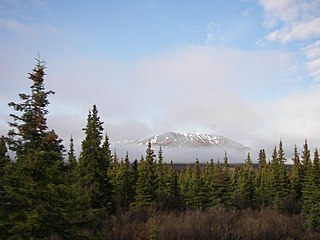
The Taiga of North America is a Level I ecoregion of North America designated by the Commission for Environmental Cooperation (CEC) in its North American Environmental Atlas.













